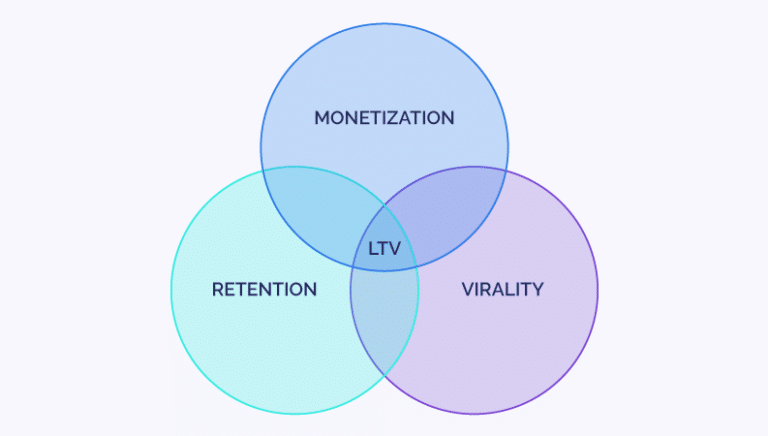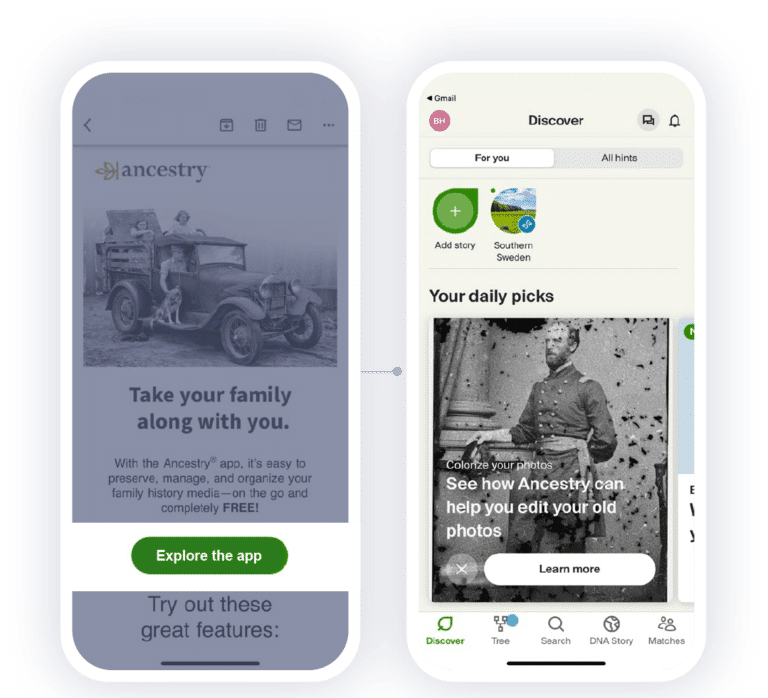For a marketer to successfully measure the return on investment (ROI) of a growth or marketing campaign, they must understand the lifetime value (LTV) of their users. Also called customer lifetime value (CLTV), LTV is exactly what it sounds like — the average value of a customer or user over their lifecycle with your app.
However, the jury is still out on the best way to measure LTV. Many in the industry acknowledge that there are multiple ways to measure LTV, and plenty of companies leave it to the app marketer or developer to choose, depending on their type of app and the metrics available to them.
Although the structure of the LTV equation is hotly debated, there is one thing that all developers seem to agree on — the variables that go into it. Improving any of these variables will improve the value of your users:
- Monetization: Revenue generated from your mobile app, measured by average revenue per user (ARPU).
- Retention: The degree to which users continue to use your app after install. Retention rates look at usage over a specific period of time (days, months, etc.).
- Virality: How many new users your existing users will bring into the app (user-generated growth).
Now the obvious question is, how do I improve the variables that impact my app’s customer lifetime value? One option: deep links.
Increasing lifetime value with deep links
Knowing the LTV of app users opens up a whole new world for experimentation and growth. Once you can calculate LTV, you can prioritize and measure the impact of building new features or testing different marketing campaigns. Since LTV is a function of three variables, as an app developer or marketer you have the choice to focus on the variable you think will impact your LTV the most. For instance, if you know monetization will come later once you reach scale, focus on virality and retention in the short term. If your users share a lot but have a short lifecycle, deep linking for retention is for you.
App monetization
Deep links have obvious use cases when it comes to virality and retention, but they’re also incredibly useful for your app monetization efforts, specifically because of their ability to move users further down the customer acquisition funnel.
Moving app users down the funnel
The purpose of the funnel is to demonstrate that the number of potential customers decreases with each step the user has to go through to become a customer. So it makes sense that it’s best to skip as many of these stages as possible. That’s where deep links come in.
Take Jersey Mike’s, for example. The company uses Branch Quick Links across various channels, including paid, organic social, SMS, and push notifications to convert non-app users to app users. But it doesn’t stop there. The deep link stores the parameters of the incoming user, bringing them directly to the content in the app they were viewing on mobile web. Their first time using the app, users start just one step from placing an order, automatically applying an offer they just saw on a different channel.
Decreasing the cost of customer acquisition
For many apps — especially those that don’t generate revenue or plan on flipping the monetary switch anytime soon — decreasing the cost of customer acquisition (CAC) is just as important as optimizing monetization. For one, paying less for new user acquisition customers allows them to scale to a point where they can monetize faster. If they don’t have plans to monetize, a decreased CAC may allow them to reach a point where this is another, non-monetary value in the network they’ve created. Whatever the reason may be, decreasing CAC is always on an app developer’s or marketer’s mind (hence why acquisition costs were listed among the top three challenges facing app marketers in 2022).
Rummy Passion, a leading digital card game platform in India, decreased its customer acquisition costs for affiliate campaigns by 30% using deep links. It implemented Branch mobile ads attribution across Facebook, Google, and affiliate partners, consolidating its paid marketing reporting into the Branch Dashboard. The team was then able to look at all of its advertising channels in a single, unified view. By creating a deep link for each new campaign, it accurately attributed campaign performance and improved the user journey to the app. Some of its major affiliate partners even saw a 10x increase in attributed sales.
Retaining and reengaging app users
The second variable of the lifetime value function is retention. Retention is important for LTV because it defines the active lifecycle of an app user. Deep links not only improve retention, they can also reengage app users you may have lost. In both cases, the lifetime value of a customer increases.
Improving user retention
Mobile users are fickle. Branch found that the average mobile app loses 77% of its users within the first three days after they download. The average churn rate after one month is 55% and after three months, it’s 68%. So although three months doesn’t feel long, for mobile app users, it can be a lifetime.
La Redoute, a French fashion, lifestyle, and home furnishings brand increased its 30-day retention by 29% with strategically-implemented web-to-app banners. Upon visiting the mobile website, users were served Journeys banners and interstitials encouraging them to interact with the La Redoute app. New customers received tailored messaging and app-only offers, incentivizing them to tap “download.” Meanwhile, the company helped returning customers rediscover the app with app-only discounts and banner reminders. Thirty days post-acquisition, user retention for users acquired via Journeys was 29% higher than users acquired via paid advertising and 26% higher than organic app users.
Deep linking for reengagement
No app is perfect. Even if you can improve retention, you’re still going to lose users. But they may not be gone forever. There are certain retention techniques that utilize deep links to boost reengagement.
One benefit of Branch links is that once you create a link, it will work across any platform or use case. For example, email campaigns are a common, effective way to reengage users. Email marketers can send users information about promotions, limited-time offers, and even personalized, dynamic content. But email reengagement is notoriously difficult. Without a dedicated mobile linking platform, brands often have to choose between analytics and user experience.
Ancestry®, a family history and consumer genomics company, implemented deep links in its email campaigns to encourage users to reengage with the app. The campaign titled, “The Ancestry app can do that?” included calls to action (CTAs) to “Explore the app” and took users directly inside the app to explore the highlighted feature. By integrating its app and deep linked emails, the company drove a 3x increase in engagement with app features.
Building virality into your app
The final factor of an increased user LTV is virality. Virality is a cyclical engine that results in your existing users inviting their friends or followers.
Improving the likelihood of app sharing
One of the most-effective ways to help an app go viral is to utilize user-generated sharing links, so users can send their favorite app or piece of content to their friends in just a few taps. Yet one of the main challenges with traditional sharing links is that they go straight to the mobile web, even if the recipient has the app downloaded. Links passed through social media often leave users in walled gardens, as social platforms try to keep users on their platform. By ensuring your sharing links are deep links, you can enable users to send links to peers that take them directly to specific in-app content, and attribute that share back to the app.
Pandora uses a custom share sheet with personalized CTAs. They let users share links to songs or playlists via multiple platforms, like text message, Instagram, WhatsApp, and more. Thanks to a Branch deep link, recipients of the link are taken directly from the link to the very song that was shared.
Tracking and rewarding referrals
App developers and marketers know that existing users are key to virality and often try to reward or incentivize these users for inviting others. However, building out complex referral programs proves to be quite a difficult task. With Branch referrals, all the logic, routing, and rewarding is handled automatically. Better yet, since Branch links can store user parameters, there is no need to use referral codes to receive rewards, further reducing one or more steps in the customer acquisition process.
Rappi used this referral system to equip its 15,000+ influencer marketing partners with unique coupon codes to offer to their followers. These coupons provided a discount for the new user’s first purchase on Rappi and were attached to Branch deep links. When a new user clicked the link, they were taken to the correct app store for their device, and after installing the app, the coupon was automatically applied to the user account. On the backend, Branch captured all the information about the influencer, channel, and coupon, so Rappi could track each influencer’s performance. As a result, 50% of new users came from influencer and referral campaigns.
Overall impact of deep links on customer lifetime value
Now that you’ve seen some proven examples of how to use deep links to improve app monetization, retention, and virality, it’s up to you to determine and prioritize which deep link use cases to try. The impact of Branch features on LTV will vary depending on several different factors. What vertical is your app in? Are users incentivized to share? How long is your average customer’s lifecycle? To start, look at your app’s current monetization, retention, and virality performance and see which aspect needs the most attention.
At the end of the day, no matter which equation you use to measure LTV, deep links will help.
Want to learn more? Request a demo with our team.

























